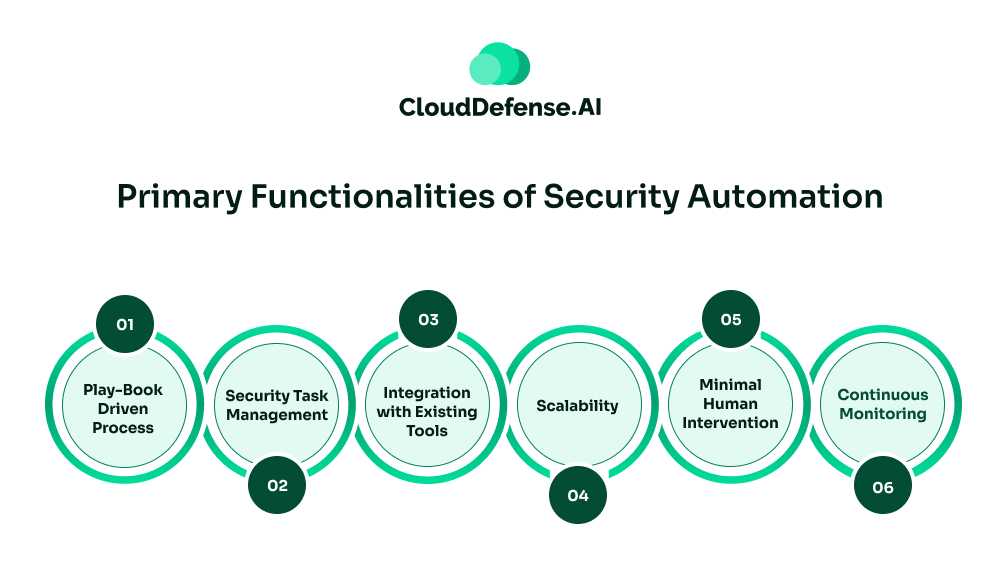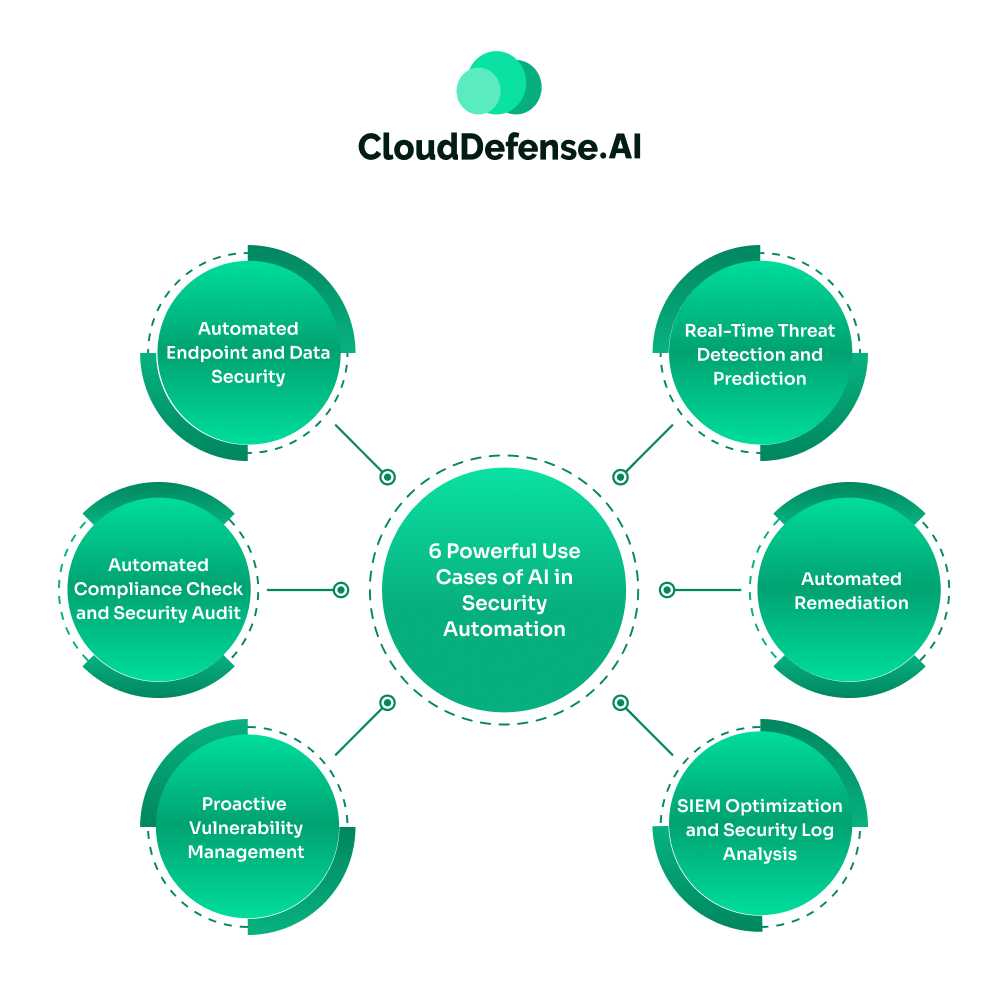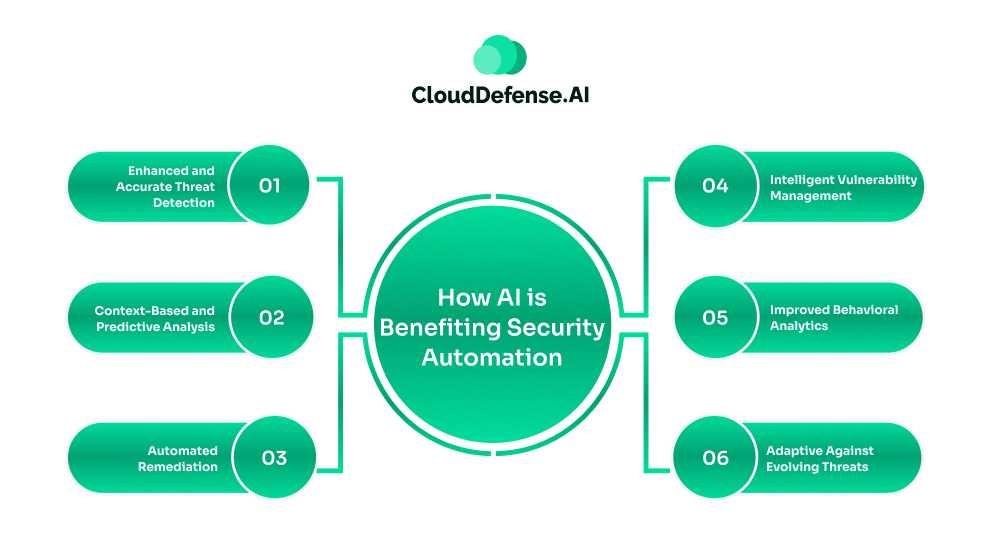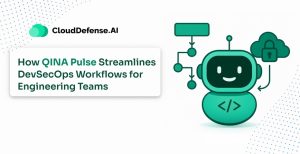With time, modern technology is progressing in leaps and bounds, and so are the cybersecurity threats. Attackers are now using advanced methodologies to perform a variety of cybercrimes. Even though organizations are turning to security automation, it still lags behind the increasing and ever-evolving cyber threats.
To tackle this, organizations are rapidly adopting Artificial Intelligence-driven security automation. It is more effective and adaptive, and can quickly identify and respond to advanced cyber threats. AI-based security automation leverages machine learning, huge databases, and modern algorithms to predict attacks and ensure compliance. This guide will take you through six powerful use cases for AI in security automation.
What is Security Automation?
Security automation is an automated process that leverages modern technologies to perform repetitive security tasks. It mostly helps with automatically identifying, investigating, and fixing security threats without or with minimal human intervention. It is accomplished using various playbooks, specialized solutions, and automated tools that are built with Artificial Intelligence and Machine Learning.
It also transforms manual tasks like vulnerability management, compliance checks, and incident response into an automated process. The main goal is to reduce the workload of the security team and improve the overall security posture.
Security automation streamlines all the security-related operations, allowing teams to scale their security efforts and efficiently respond to security threats. It serves as an intelligent security assistant that works continuously to respond to breaches, maintain an optimum security posture, and help with security orchestration through integration.
Primary Functionalities of Security Automation

- Play-Book Driven Process: Traditional security automation processes are based on predefined playbooks or rules. All the actions are triggered based on predefined security events.
- Security Task Management: Security automation is designed to automate routine security tasks that are repetitive, time-consuming, and prone to human error. From threat detection, vulnerability scanning, and compliance checks to patch management, it takes care of most tasks.
- Integration with Existing Tools: A key functionality of security automation platforms is that they seamlessly integrate with your existing security tools. It merges with EDR, vulnerability management systems, and SIEMs to offer a proactive defense against threats. In some instances, it is often integrated through SOARs and endpoint protection platforms for advanced security orchestration.
- Scalability: With time, the attack surface of your organization will expand. It automatically helps in scaling the security operation according to the requirement without reducing efficiency and effectiveness.
- Minimal Human Intervention: With security automation in place, your development and security team won’t have to perform many tasks manually. As a result, there is minimal human error that often leads to delayed responses and plausible attack surfaces. Importantly, it enables your security professionals to focus on complex security tasks that require complete human intervention.
- Continuous Monitoring: Security automation with integration with other security tools can perform continuous monitoring of your security infrastructure. It will ensure constant vigilance and often provide alerts when an anomaly is detected.
6 Powerful Use Cases of AI in Security Automation

Here are six prominent use cases for AI in security automation that you should know about:
Real-Time Threat Detection and Prediction
A critical AI automation use case is real-time threat detection and prediction. AI empowers security automation tools to proactively identify and predict security threats with high accuracy. AI-driven security automation offers:
- Anomaly Identification: AI-based security automation often works with SOAR and SIEM to continuously monitor and analyze large data sets to identify any subtle malicious patterns in real-time.
- Zero-Day Protection: AI models are continuously learning from new data streams and evolving attack patterns, enabling security automation to quickly identify zero-day attacks. It can accurately detect novel attacks and help you to improve your security guardrails.
- Suspicious Behavior Detection: Along with AI, machine learning algorithms are also utilized by security automation tools to identify anomalies in system and user behavior. It can automatically create a standard baseline and identify if the system or user deviates from it.
- Prioritized Alert: Modern security automation systems, along with AI, can prioritize alerts based on their severity. It leverages several AI models and datasets to prioritise security findings based on their impact.
Automated Remediation
Artificial Intelligence also plays a major role in enabling security automation for automated remediation. Quick remediation action is a necessity when a threat is detected in your system, as it will minimize any impact. AI through security automation triggers the remediation action needed to contain the security threat. AI, in this case, helps the security automation through:
- Intelligent Triage: AI enables security automation tools to automatically perform triage on the detected threats and prioritise them based on their impact. It helps in remediating threats that have the most impact.
- Automated Response: AI with integration of SOAR can initiate predefined remediation actions to fix the security threat. The remediation response usually ranges from containing the affected system and quarantining files to blocking the main source.
- Threat Data Collection: In some AI-powered automation, you can also configure it to collect all the threat data. It will help the security team to identify the main causes, origin, and make improvements accordingly.
SIEM Optimization and Security Log Analysis
SIEM and security log analysis are another powerful use case for AI in security automation. Usually, the servers, applications, firewalls, and other components in your organization generate a lot of security logs and event data. SIEM is usually tasked to collect that data and help with analysis. AI through security automation automates the collection and analysis process.
- Intelligent Aggregation and Correlation: AI models utilize machine learning to analyse huge datasets and correlate security events from different data streams. It helps in identifying correlated threats, nuanced patterns, and complex attack chains that are not possible to detect with traditional methodologies.
- Automated Investigation: These tools using AI can automate different segments of the investigation process. It can gather all the information related to the event and provide an actionable insight that can be used by your security professionals.
- Threat Intelligence: AI models ingest intelligence data from various sources and provide alerts with real-time contextual information. It understands the techniques and procedures of different threats and uses the information to identify future threats.
Proactive Vulnerability Management
AI through security automation transforms vulnerability management from a reactive process to a proactive approach. It enables your security team to identify security vulnerabilities and mitigate them before they have any major impact.
- Automated Scanning and Identification: AI, in conjunction with security automation, continuously scans the source code, network, and system to detect potential vulnerabilities. Generative AI often comes into play to automatically simulate cyberattacks and help in improving guardrails.
- Predictive Assessment: AI, by sourcing real-time threat information and historical data, can predict which vulnerability might occur or will be exploited. It alerts your security teams and helps them to bolster the security measures to prevent any impact.
- Vulnerability Remediation: AI through security automation also helps in remediation actions. It helps in automating security patches deployment, validating patches, or ticket generation.
Automated Compliance Check and Security Audit
A major AI automation use case is automating compliance checks and security audits. AI empowers security automation to automate the governance, risk, and compliance process and maintain adherence to regulatory requirements. AI helps by:
- Continuous Compliance Check: Staying compliant with regulatory requirements like GDPR, PCI-DSS, or ISO 27001 is a continuous process. AI-powered security automation can continuously monitor your security infrastructure and ensure it aligns with regulatory standards.
- Policy Enforcement: Security automation with AI helps in automatically enforcing security policies that help in maintaining adherence to all regulatory requirements. It is also useful in identifying deviation from baseline policies.
- Automated Security Audits: AI also enables security-automation tools to automatically collect data related to compliance, generate compliance reports, and policy violation details. It helps in streamlining and automating the security audit process.
Automated Endpoint and Data Security
The rise of remote work trends has made it a necessity for every organisation to secure the endpoint and data. AI integration in security automation tools assists in actively protecting your endpoint assets and data associated with them.
- Automated Endpoint Protection: AI through security automation assesses the behaviors and identifies threats in real-time. Whenever it detects any malicious activity, especially zero-day attacks, it quickly takes pre-defined remediation actions.
- Proactive Data Security: AI assists in constantly monitoring the network to discover any sensitive data and classifying it. It provides alerts when it detects any unauthorized access or malicious activity that can lead to an insider threat.
How AI is Benefiting Security Automation

Artificial Intelligence (AI) has a huge impact on the security automation process. It powers the process with intelligence, adaptability, and accuracy. It transforms the traditional security automation from being a playbook-based process to an intelligent and dynamic platform. Here is how AI benefits security automation processes:
- Enhanced and Accurate Threat Detection: The AI integration in security automation enables it to quickly assess large datasets and identify any subtle variation from the baseline. As a result, it accurately identifies nuance patterns or anomalies in real time.
- Context-Based and Predictive Analysis: AI powers security automation with contextual awareness by assessing various data sources. It helps the tool properly understand a security incident and classify whether it is a real threat or not. Moreover, AI can assess all the historical and current trending data to identify patterns that can lead to attacks.
- Automated Remediation: When an anomaly or security threat is detected, AI, through the security automation, can deploy appropriate predefined remediation steps. It not only helps with proactive incident response but also reduces any chance of impact.
- Intelligent Vulnerability Management: The addition of AI enables security automation processes with intelligent vulnerability management. It helps with prioritizing vulnerabilities based on different factors and highlights the ones that have the most impact. It enables your teams to quickly respond to threats with the utmost severity.
- Improved Behavioral Analytics: Artificial intelligence greatly improves behavioral analytics. It automatically creates profiles of all the users and entities in your organization and continuously monitors them. Thus, it detects any subtle variation in their behavior that can lead to an insider threat or other security threat.
- Adaptive Against Evolving Threats: By leveraging the power of AI, security automation can adapt to modern cyber threats and advanced techniques. It helps in enhancing threat identification and automated incident response capability against evolving threats.
Bottom Line
Artificial Intelligence (AI) is not only enhancing the capabilities of security automation but also enabling it to intelligently automate most security tasks. Whether you want to automate threat detection, incident response, or the remediation process, AI with security automation is streamlining everything. The 6 powerful use cases for AI in security-automation showcase how you can leverage AI and build a proactive and robust security infrastructure. When it comes to advanced AI-based automation tools, QINA Pulse has emerged as a powerful choice that acts as your intelligent AI security assistant. You will have to put a command in simple English, and it will automate all the security tasks according to your requirement. It is a context-aware AI-powered tool that is designed to meet all your security-automation requirements. Without looking further, book your free demo and check how QINA Pulse unfolds its magic.







